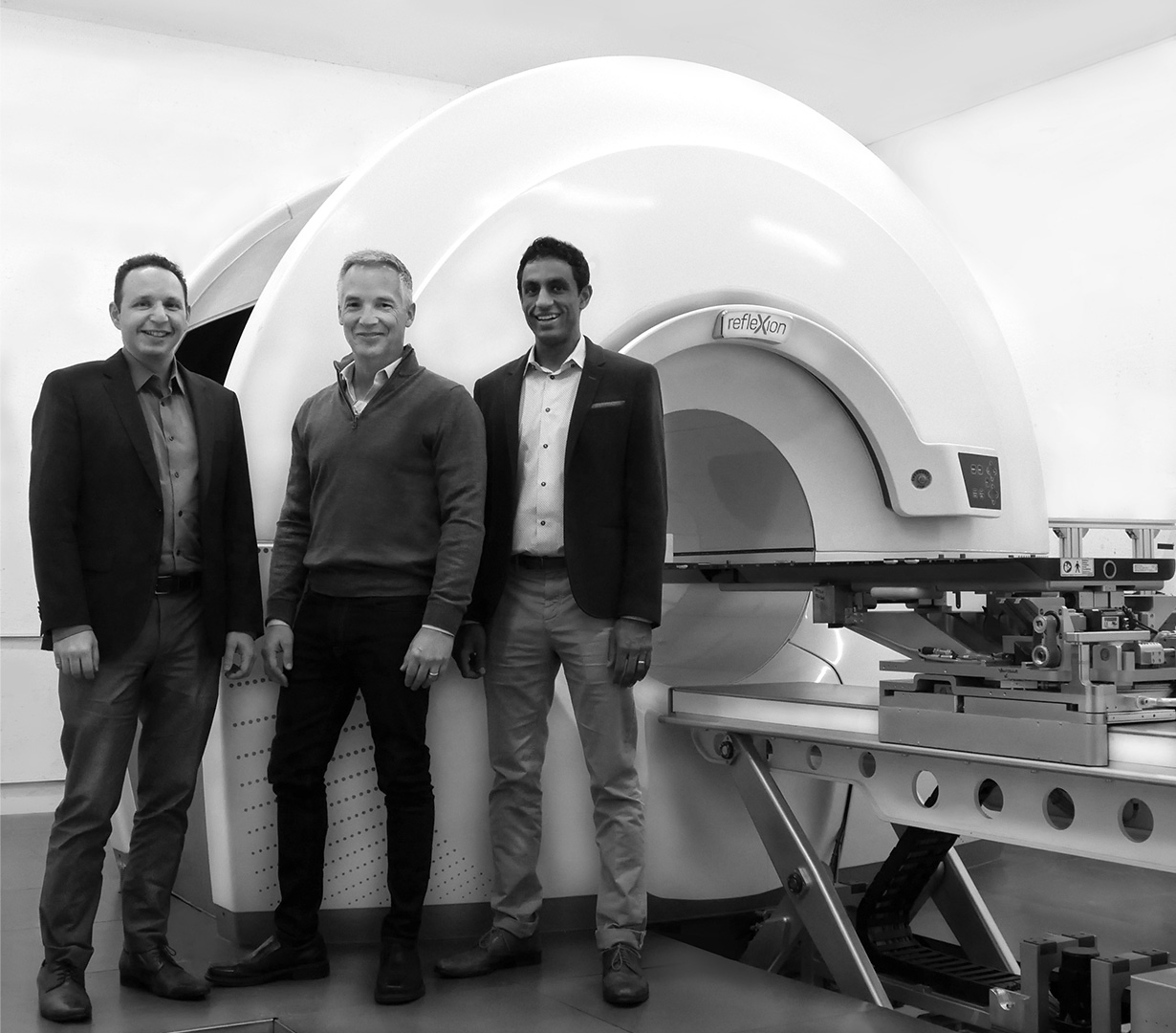
RefleXion X1
Whopping Milestone Achieved—Doctors at Stanford Treat Cancer Patient on RefleXion X1
May 26, 2021
For the first time ever, a patient was treated on the new RefleXion X1 machine by physicians at Stanford Radiation Oncology. The momentous event is not only a significant milestone for RefleXion Medical, but it also offers a glimpse into the promising future of cancer treatment.
“It is such an impactful milestone because it marks the first time we are fighting cancer, literally,” says Sam Mazin, Ph.D., RefleXion’s founder and CTO. “I’ve waited for over a decade for this moment, which was the culmination of so much hard work across every function in our company.”
Todd Powell, RefleXion’s president and CEO explains there have been many ‘firsts’ for the company over the last 15 months—the first regulatory clearance, the first customer, and the first pharmaceutical partnership—but the first patient treatment, “stopped me in my tracks,” he says.
“All of us in the field of cancer care like to think of ourselves as ‘patient-centric’ and I believe we’re truly committed to all that comes with that; however, there is something remarkable about the first patient treated that makes it more real, more serious and more relevant than before,” continues Powell. “It’s a line that, once crossed, puts everything else into a more serious perspective. The expectations of us are higher and we must deliver. It’s as simple as that. Patients, and those who provide their care, are counting on us.”


For over a decade, RefleXion has been feverishly working to move its technology through critical stages. “We needed to prove the technical concept; prove we could build a product; prove we could manufacture and market it; and prove we could sell, install, commission and service the X1,” says Mazin. “Perhaps the most critical of this last phase is that we needed to prove we could treat a patient. This first patient treatment at Stanford was the very first time our therapeutic device would affect someone with cancer, marking the beginning of clinical adoption in the U.S.”
David Larkin, the company’s senior vice president of research and development, who is employee No. 4, says he joined RefleXion in 2014 because he saw an opportunity to really help people—to design something that could dramatically improve cancer treatment. It also provided him an opportunity to help build a company that would be an engine for future advances in cancer care. “That longer-term vision is always there on the periphery, but the task is so complex, with so many ways it can go wrong, that the day-to-day is almost always focused on the near-term—the very next technical or organization problem,” he says. “But helping another human being with their cancer isn’t a mere technical or organizational accomplishment. It’s a societal one. So, in some ways, it feels like ‘coming full circle’ and ‘back to why we started.’ In other ways, it feels like a crossing—like we’ve come out of a thick forest into the sunshine.”

And on Twitter, Stanford Radiation Oncology tweeted, “The clinic announces they are officially live and incredibly proud to deliver the first radiation treatment on a patient using the RefleXion X1 machine.” In a reply tweet, @StanfordRadOnc adds: “We could not have done it without the countless hours of effort from our physicians, physicists, dosimetrists, RTTs, IT team, and the support of our whole department. One step closer to Biology-guided Radiotherapy.”
RefleXion is developing the first biology-guided radiotherapy (BgRT*) system, a significant change in strategy from single tumor therapy to the ability to one day treat multiple tumors in the same treatment session in cancers that have metastasized. BgRT incorporates positron-emission tomography (PET) imaging data to enable tumors to continuously signal their location. This technology will synchronize these data with the linear accelerator to direct radiotherapy to tumors with sub-second latency.
Powell, who has spent over 30 years leading worldwide companies and developing innovative products in cancer care, says he felt a huge sense of relief and excitement when he learned the first patient treatment went smoothly, but then he felt a much more ever-present sense of urgency for all the work that lies ahead.
“I’ve been fortunate enough to help create and deliver cancer care products that have treated over a hundred-thousand patients a day, all around the world,” says Powell. “The first patient treated is incredibly important—they all are—but in many ways, the first one urgently reminds me of all the other patients we haven’t treated yet.”
For the company and its more than 200 employees, there is no better feeling than achieving a goal like this, which represents so much dedication and hard work.

“Developing a technology that could really change cancer care and seeing it realized in a patient treatment for the very first time is a moment forever sealed in my memory and branded in my heart,” says Mazin.
It was just 65 years ago that the first medical linear accelerator in the western hemisphere was installed at Stanford-Lane hospital in San Francisco, where it was used to treat a boy suffering from retinoblastoma, a cancer of the eye1. In a press release issued on April 27, 1956, Stanford University announced that its long-awaited “cancer gun” was unveiled today at Stanford Medical School in San Francisco. That machine was retired in 1972 and resides at the Smithsonian Institution.1
Today, advances have improved the effectiveness of radiotherapy significantly, yet even more promising technologies are on the horizon. As such, the X1 machine with BgRT is designed to overcome the technical limitations that currently restrict radiotherapy to one or two tumors. When available, RefleXion will scale BgRT to treat all visible tumors, even those that move rapidly due to bodily functions such as breathing or digestion, in the same treatment session.
*The RefleXion™ X1 is cleared for SBRT/SRS/IMRT treatments. BgRT is limited by U.S. law to Investigational use.
1https://news.stanford.edu/news/2005/may18/med-accelerator-051805.html




